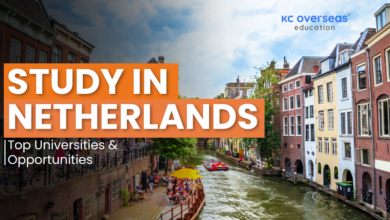Study in Canada – Steps to Follow & Benefits
To study in Canada, there are four steps: selecting a course of study, obtaining an acceptance letter from a Canadian institution, obtaining a provincial attestation document from the province or territory in which the institution is situated, and, last, obtaining a study permit. Studying in Canada gives you an additional opportunity to apply for permanent resident status, which is one of the main benefits of doing so.
Steps to Follow to Study in Canada
The actions you must take in order to study in Canada and obtain permanent residency are as follows:
Select a Program
Find the Canadian education program you wish to enrol in by doing some research.
Apply to a Canadian Designated Learning Institution
Apply to the designated learning institution (DLI) in Canada that best suits your needs after deciding which educational program to pursue.
Apply for a Study Permit
Apply for a study permit from the Government of Canada after receiving an admission letter and a provincial attestation letter from the province or territory where your school is located. Most people require a study permit in order to be able to stay in Canada as students legally.
Explore Immigration Options
You can stay in Canada to obtain further professional work experience after finishing your courses and applying for permanent residence.
Benefits of Studying in Canada
Canada is one of the most popular study-abroad destinations worldwide, currently housing over 800,000 international students from all over the world. Studies reveal that various factors, including the excellent education provided by Canadian schools, draw international students to Canada. International students can work in Canada both during and after their studies and apply for permanent residency.
Additionally, students have the option of studying in French or English. Canada boasts a cosmopolitan society, safety and security, and an annual intake of international students and immigrants from approximately 200 nations. When compared to other well-liked foreign student locations, Canada is reasonably priced.
Colleges & Universities in Canada
International students are welcome to study in Canada at more than 1,500 universities, colleges, and other educational establishments that have been approved by Immigration, Refugees and Citizenship Canada (IRCC). These educational establishments, known as DLIs (Designated Learning Institutions), were created to assist international students enrolled in Canadian universities and continuing to reside in the nation following their graduation. The list of DLIs that the IRCC has approved is continually expanding. Please confirm that the IRCC approves the college, university, or other establishment you want to attend.
As the two most populous provinces in Canada, Ontario and Quebec are home to the majority of DLIs—nearly 1,000 in total. There are a lot of DLIs in Canada, so chances are good you’ll discover an educational program that suits your needs. In general, Canadian universities provide similar standards of excellent instruction. This is because Canada aspires to ensure that all students, regardless of the institution they attend, receive the finest education possible through the promotion of equity within its educational system.
About 150 community colleges in Canada provide high-quality education as well. Universities focus on teaching theory and preparing students for certain careers (such as law, engineering, or medicine). In contrast, community colleges provide more practical training to assist students enter the workforce more rapidly. College curricula are more applied, with the goal of equipping students with skills that will enable them to obtain employment in their field of study. Similar to universities, colleges in Canada often provide comparable educational opportunities. Studying in a Canadian institution should reassure international students because the degree they get will help them with their post-graduation professional and immigration goals.
Pathways to PR (Permanent Residence) for Students
After completing their post-secondary education in Canada, international students have a number of options for extending their stay and eventually becoming permanent residents. You can have an edge while applying for permanent residence in Canada because of your education in the country. Candidates with Canadian education and job experience are highly valued in several federal and provincial immigration programs.
By acquiring a PGWP (Post-Graduation Work Permit), which may allow you to work in Canada for up to three years, depending on your Canadian academic degree, you can gain Canadian job experience after completing your studies in Canada. You can then seek a variety of federal and provincial pathways for permanent residency while in possession of a PGWP, including:
Express Entry
One of the most popular methods is applying for permanent residency through Express Entry. Canada handles applications for immigration based on economic class, primarily through Express Entry. Candidates for Express Entry are evaluated using the Comprehensive Ranking System, or CRS. The CRS recognizes and rewards candidates with strong English and/or French proficiency, Canadian work experience and education, and a young age. Many of the foreign students studying in Canada have these qualities.
Former international students may be able to qualify for the well-liked CEC (Canadian Experience Class) program through Express Entry. This program allows tens of thousands of temporary foreign workers and former international students to become permanent citizens each year.
Provincial Nominee Program (PNP)
Provinces and territories in Canada can use the PNP (Provincial Nominee Program) to find immigration applicants who fit their specific economic needs. Candidates who were previously overseas students and finished their studies in Canada or who are committed to serving foreign students are rewarded in several PNP programs.
Quebec
Quebec is Canada’s second-largest province, and Montreal is a well-liked study destination for foreigners. With policies distinct from those of the PNP and the federal government, the province runs its own immigration system. Quebec additionally promotes the transition of former international students to permanent residency. The Quebec Experience Program is a noteworthy avenue through which it attempts to do this.
Other Federal Programs
Apart from the three programs it oversees under Express Entry, the federal government runs other programs related to economic class immigration. For international students to study in Canada, the programs offer special streams and waivers from the Canadian work experience requirements. These consist of the Rural and Northern Immigration Plot and the Atlantic Immigration Program.



